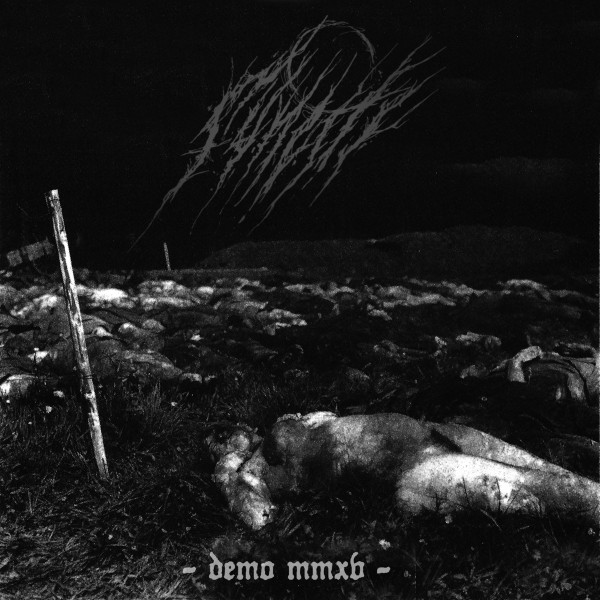Beginning with an interesting melodic progression, picked on an acoustic guitar and accompanied by background noises of synthesized chords and muffled mechanical noises, the title track and introduction to Le Triomphe du Charnier suggests a world of underlying mystery and danger. After a noisy segue into the second track, we find that, not surprisingly, the music of Funeste is hardly acoustic guitar-oriented. Dual-guitar distorted riffs are constructed like a highway for heavy traffic, as one guitar militantly plugs away at a rhythm and sticks to one chord while the second guitar plays a melody that races along the foundation of the first guitar, taking twists and turns in cycles before switching to a new course once the harmonic tension is exhausted and the low-register rhythm guitar changes chords and opens up new paths for the flightier second guitar to navigate. This “lead guitar over rhythm guitar” approach is hardly a novel one for metal or rock music but Funeste pulls it off elegantly and with a very natural (rather than formulaic and unimaginative) feel, as the best of the classic black metal acts (Emperor and Immortal come to mind) have done. Vocals appear at the proper moment, reverb-laden and rather indistinct phonetically-speaking, but serving a purpose (through the stretched-out screams that decay slowly) as each vocal line connects riffs either from beginning-to-end or through transitions, from end-to-beginning.
During the second track which is the first fully proper song, Funeste displays an adroit sense of how to piece together their songs smoothly without relying on any uniform structure. The first really outstanding riff involves a downward chromatic drop that loops a handful of times before giving in to a less-disorienting melodic progression. After the lyrics have been vocalized, the progression then reiterates the downward drop once more before charging into the “outro”, the riffs that lead the song to its conclusion. This method of structuring a song is also traditional of great black metal; play a riff (A) that leads into a harmonically related riff (B), eventually looping back to the original riff (A) before boldly rushing into a new melodic territory altogether with a new riff (C).
Funeste still make a handful of strange choices that may be chalked up to oversight on their part due to inexperience, or the choices may be conscious and intended to disorient the listener. Either way, there are some awkward transitions like a “bridge” near the end of the third track, Le Passager Invisible, which is made of strange background noises and a slowly plucked guitar melody with minimal percussive intervention. The band meanders lethargically through this segment for a while before abruptly breaking into a high-speed tremolo-picked riff that closes out the song. This is likely to disorient the listener since smooth transitions have been the norm up to this point, and something like a steady increase in tension would be expected as the band moved from a slow, clean-sounding section to a high-speed aggressive-sounding section. Instead, we as listeners are lead delicately along a cliff edge, allowed to take cautious glances over the side and, then, before getting a chance to really let the danger of our predicament sink in, booted clean off the ledge and dropped into freefall. While the effect is intense, it is not congruous with the smoothly-flowing nature of the rest of the song and serves as a “magic breaker” that snaps us out of our imagination and reminds us that we are only listening to a song, not experiencing a journey.
Further, there is a tendency for the musicians (in particular, the drummer) to suffocate the gripping melodies of the guitars with redundant ornamentation. The drums were apparently played by someone with a love of hip-hop-style grooves and amphetamines. While there is nothing inherently wrong with enhancing your drumming skills with amphetamines, this guy’s style often detracts from rather than enhances the melodies because he overplays the two drums that have the sharpest percussive attack – the snare and kick drum – in flailing, jolting beats that sometimes resemble overlong fills that draw most of the listener’s attention and end up leading nowhere. This is an unforgivable sin as it achieves the opposite effect of emphasizing the most important part of the music – the melody – by obfuscating the note changes. Imagine reading an engaging story, written with carefully-chosen words, but sprinkled randomly with periods, semicolons, parentheses, and ellipses. That is akin to the experience of listening to well-written music with intrusive drums. Still annoying but to a lesser degree, a guitar will sometimes break into a nonsensical stream of artificial harmonics or other obnoxious noise, but these fits are few and far between and don’t detract so much from melody as just add some uncalled-for ornamentation.
Beyond musicianship alone, Funeste have added too many background “found sounds” or just strange digitally-manipulated noises that add nothing to the “atmosphere”, which I assume was the reasoning behind adding these extra layers. There are two reasons why this is bad:
1. The riffs that are more harmonically sparse lose their dynamic capacity from being drenched in washes of amelodic background noise, and begin to sound even denser than the full-on blasting sections.
2. It makes the band seem underconfident in their ability to let the melody carry itself and express emotion, mood, thought, sense, experience, which the melody is perfectly capable of doing if just given some breathing room.
Much of the time, new bands (particularly those trying to play black metal) try to get away with being so simplistic that they sound like a really stoned punk band that can’t count how many measures they’ve been through and end up making ten-minute songs out of the same two chord progressions. Others focus so much on “technicality” that they end up playing something like etudes for guitar wankers. Funeste is special for committing neither sin; they have given us some good melody-focused work here that will benefit from having the extraneous elements removed.
https://www.facebook.com/funestemtl?fref=ts
No CommentsTags: 2015, Black Metal, Funeste, Le Triomphe du Charnier, modern metal



